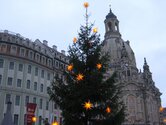The Neumarkt in Dresden
By the expansion of Dresden Fortress in an eastward direction in the 16th century another market place came into being – Neumarkt (New market). Until 1945 the Neumarkt with its circumjacent alleys was counted among the most beautiful townscapes of Dresden. The noble baroque and rococo façades of the middle-class houses with bays, ornaments and portals had been treasures of 18th century architecture. The bombings of February 1945 razed the whole of the Neumarkt-area to the ground. Up to 1993 the ruins of the Frauenkirche soared ghostlike as a memorial against war. Now Frauenkirche and Coselpalais are rebuilt, and together with the accommodations in historical countenance under construction, another cultural center of Dresden will be revived.
Church of our lady (Frauenkirche)
At one time financed by the Dresden citizenry the Frauenkirche, the masterpiece of George Bähr (1666 - 1738), was built between 1728 and 1743 beside the long in a ruinous condition old Frauenkirche as a 91 metres high baroque central-plan building with a boldly towering sandstone dome (diameter of 23.50 metres). An initiative, for reconstruction of the Frauenkirche succeeded by a worldwide appeal for funds to collect benefits totalling 180 million Euros. Work began on 27th May 1994 and the crypt could be consecrated already in August 1996. On 30th October 2005 the time had come. 60.000 people of Dresden and guests from all over the world gathered together on Neumarkt to witness the consecration service on the ground. The church is varied venue, centre of attraction for guests of the town par excellence, and from the tower a glorious view over Dresden and the Elbe Valley Basin (Elbtal) is offered.
Coselpalais
This house got its name from count Friedrich August von Cosel (1712 - 1770), a son of August the Strong (1670 – 1733) and countess Cosel (1680 - 1765), who used to live here. As a beautiful example of the once numerous living palaces of the nobility of the courtyard in Dresden it was reconstructed true to original after the destruction in World War II, and finished in the year 2000.





















